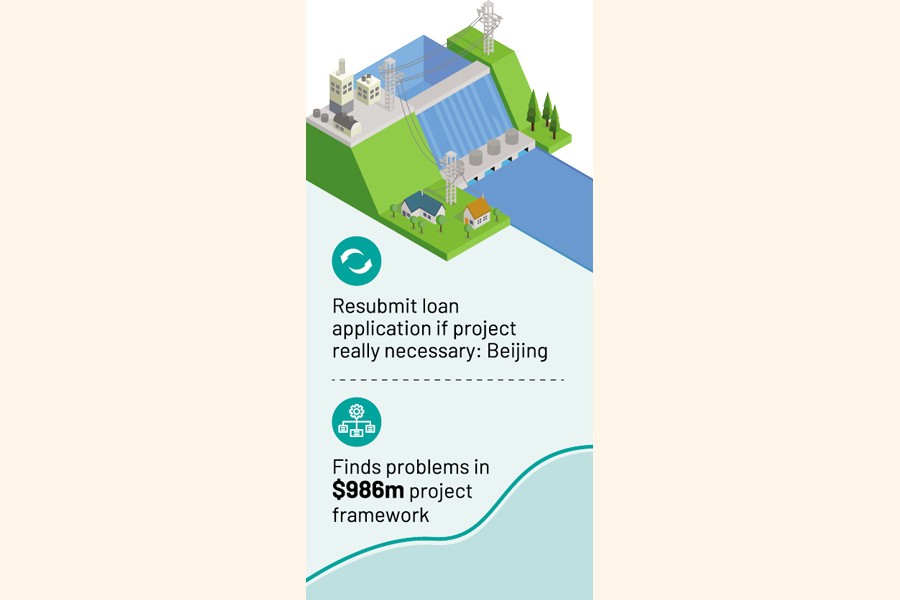
Published :
Updated :

Bangladesh’s loan application for the much-talked-about Teesta River project has failed to hold water in the ‘preliminary evaluation’ by China, reportedly for some gaps mainly in cost-benefit calculations.
However, the Chinese side assured its highest consideration for the ‘Teesta River Comprehensive Management and Restoration Project’, saying that Bangladesh should resubmit the loan application with a revised implementation plan ‘if the country believes that the project is really necessary’.
Bangladesh sought 725 million dollar from China for the 980-million- dollar project aimed at ensuring better water preservation in the river that enters the country from India.
In its evaluation China is learnt to have detected several problems regarding the investment size, feasibility study and land-development plan.
The evaluation report notes that the investment amount of the project is large and there is a large uncertainty of using the future land income as the main source of repayment.
According to the evaluation, the project feasibility-study report submitted with the loan application did not analyse and demonstrate the land development and development of shipping projects in conjunction with the regional economic and social development base and the current situation of shipping development.
On land development the report says the necessity of large- scale land development and utilisation and development of shipping in the watershed was not sufficiently demonstrated nor was the scale of development reasonably analysed.
Suggesting implementation of the project in phases, the evaluation report says the revised plan should focus first on solving the flood- prevention and-mitigation needs.
It suggests implementation of flood-prevention projects such as embankment, slope projection, protection and river dredging in the first phase, as these are ‘less difficult to construct, with small investment and quicker results’.
China also requires the analysis and estimation of the technical parts such as river evolution and control and guide engineering in the feasibility-study report.
“If the Bangladesh side believes that the project is really necessary for construction, please resubmit the project application and feasibility- study report and other evaluation materials after optimizing and adjusting the project- implementation plan in accordance with the above evaluation suggestions,” the evaluation report concludes, assuring ‘its highest consideration’.
The proposed construction of the project contains a number of elements such as river training, land development and utilisation, and shipping.
There are bank collapse and bank erosion in the Teesta River and it is necessary to carry out river training to improve flood-control capacity, the proposal said.
However, officials concerned in the water resources ministry felt that the government high-ups prefer not to rush for big project loan considering the ongoing economic recession and geopolitical issues.
Originating in Sikkim and entering Bangladesh through Lalmonirhat, the 315-kilometre Teesta travels 153 kilometres through half a dozen northern districts, including Rangpur, Gaibandha, Nilphamari and Kurigram, before merging with the Jamuna at Fulchhari.
There is also geopolitical sensitivity about the project as, according to Indian media reports, the scheme is seen as a Chinese effort to exert its influence on the region.
Bangladesh plans to implement the project after failing to get any positive outcome from India over the signing of the long-stalled Teesta water-sharing deal while there has been an outcry from locals against want of water in dry season and over-flooding in monsoon.
Both countries agreed to strike a deal during the then Indian PM Manmohan Singh’s Dhaka visit, but it was stalled at the fag-end for stiff opposition from the Paschimbanga government.
After a long wait, Dhaka made a move to implement the Teesta management project to store water for the river.
In 2019, Bangladesh sought Chinese funding for this much-sought-after project with a request to replace it with the Dhaka-Sylhet highway project and in November 2002 sent a formal loan application.
Though China responded to Bangladesh proposal for funding, it had always maintained a cautious stance.
Former Chinese Ambassador Li Jiming publicly said last November ‘China is cautious about the project due to the geopolitical sensitivities surrounding it’.
“China has thousand years of experience in managing rivers like Yangtze, Yellow and many others… China wants to share these experiences with Bangladesh.”
He also said, “There is also some information which says there might be some hesitation from Bangladesh side because of pressure from outside.”
According to Indian media, the Chinese engagement in the project triggers apprehension in a section of policymakers.
“Bangladesh has painted India in a bad light and for China it spells an opportunity. It’s the first time China is getting involved in a river- management project in Bangladesh,” reports Indian news portal wionnews.com.
“The Teesta river crisis is China’s opportunity to test the waters and an opportunity to whip up an anti-India sentiment, it is almost Nepal déjà vu and the bad news is that so far it appears to be working.”
The project envisages building over 100-km embankment along both sides of the river, from upstream of the Teesta barrage near the Indian border to the confluence with the Brahmaputra.
Under the project envisaged by Bangladesh, massive drainage work will be done along 115 miles of the Teesta runs inside Bangladesh border to deepen the depth of the mid-river bed.
A 115-kilometre four-lane road will be built on the riverbanks, officials said, adding that barrage-cum-road will be built at various points to improve communications along the banks of the river.
“A big reservoir will be constructed to conserve huge surplus water that flows through the river every monsoon to ensure water supply for irrigation during dry season,” says one official.
Major features of the megaproject are 108-kilometre river dredging, 173-km river embankment on either side, construction of satellite cities on both banks and preservation of assets worth Tk 1,130 billion.
The execution of the scheme is projected to create an estimated 800,000 jobs, said BWDB officials involved with the project.
mirmostafiz@yahoo.com


 For all latest news, follow The Financial Express Google News channel.
For all latest news, follow The Financial Express Google News channel.